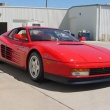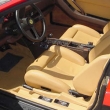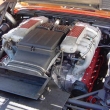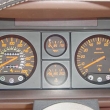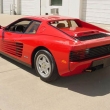1990 Ferrari Testarossa
The Testarossa was introduced to the public at the 1984 Paris auto show, and went into production in 1985. It was the first Ferrari created for the American market – at least since safety and emission laws became a fact of life in America. The Testarossa’s predecessor, the 512 BB, was never equipped for the American market at the factory, although a few cars arrived in America on the gray market with U.S. conversions to meet requirements.
The Testarossa body design was by Pininfarina, as was the 512, but the Testarossa was also built by Pininfarina, rather than Scaglietti. The body was aluminum, with the exception of the roof and doors, which were steel. Pininfarina’s wind tunnel was used extensively to develop the shape, with special attention to downforce at both front and rear.
A major change in the Testarossa was that two radiators, one on either side of the body, were mounted behind the cockpit with the air intakes extending forward almost to the front of the doors. The long intake trough was found to be necessary after wind tunnel testing. This radiator placement eliminated a major complaint from 512 owners who didn’t like the heat generated by the radiator-to-engine water pipes going alongside the passenger area. The horizontal “slats,” which some have called “cheese slicers,” were added because some countries require an opening of this size to be protected by some sort of grillework. The rear radiator placement also increased the front luggage space.
The Testarossa engine was an improved 512 design, with the same bore, stroke, displacement and horizontally-opposed cylinder layout, but with four valve-per-cylinder heads, Marelli’s new Multiplex ignition, and Bosch K-Jetronic injection. Horsepower was up to 380 at 5750 rpm, a twenty-horsepower increase over the 512, but enlarged one inch to 9.5 inches in diameter; a necessity because of the 362 foot-pounds of torque at 4500 rpm.
